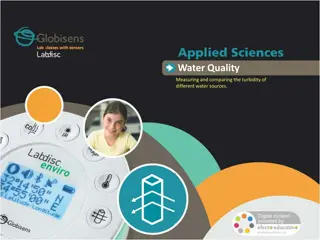Protecting Alaska's Water Quality: Understanding Tier 3 Waters
This presentation by Earl Crapps, Section Manager at Alaska Department of Environmental Conservation, provides insights into Outstanding National Resource Waters (ONRWs) in Alaska and the importance of protecting water quality. It discusses water quality standards, antidegradation policies, and the classification of Tiers 1, 2, and 3 in Alaska's water quality regulations. Emphasis is placed on Tier 3 waters, which are designated for preservation due to their exceptional ecological or recreational significance.
Download Presentation

Please find below an Image/Link to download the presentation.
The content on the website is provided AS IS for your information and personal use only. It may not be sold, licensed, or shared on other websites without obtaining consent from the author.If you encounter any issues during the download, it is possible that the publisher has removed the file from their server.
You are allowed to download the files provided on this website for personal or commercial use, subject to the condition that they are used lawfully. All files are the property of their respective owners.
The content on the website is provided AS IS for your information and personal use only. It may not be sold, licensed, or shared on other websites without obtaining consent from the author.
E N D
Presentation Transcript
Earl Crapps, Section Manager Alaska Department of Environmental Conservation Division of Water, Domestic & Industrial Utilities Alaska Forum on the Environment Anchorage, Alaska February 7, 2017
Introduction The purpose of this presentation is to provide a background on Outstanding National Resource Waters (ONRWs) or Tier 3 Waters Improving and Protecting Alaska's Water Quality 2
Water Quality Standards and Antidegradation The Clean Water Act and Federal Regulations (40 CFR 131.12) require states to have an antidegradation policy and implementation methods that: Protects existing uses Authorize the lowering of water quality ( degradation ) in high quality waters where necessary for social or economic importance Offer a mechanism to provide additional protection for water of exceptional ecological or recreational significance (ONRWs or Tier 3) 3 Improving and Protecting Alaska's Water Quality
What are Tiers 1, 2, and 3 in Alaska s Water Quality Standards Per the Clean Water Act, Federal regulations, and Alaska s Water Quality Standards regulations antidegradation policy (18 AAC 70.015) three classifications, or tiers, of waters are identified: Tier 1 waters for which not all water quality criteria are met. This can be due to naturally occurring constituents in the water, or can be due to human sources or activities. Tier 2 high quality waters, which include the vast majority of waters in Alaska. In these waters, water quality criteria are exceeded, i.e. the water quality is better than criteria. Tier 3 waters that are required to be preserved in their current status. 4 Improving and Protecting Alaska's Water Quality
5 Improving and Protecting Alaska's Water Quality
Outstanding National Resource or Tier 3 Water 40 CFR 131.12(a)(3): Where high quality waters constitute an outstanding National resource, such as waters of the National and State parks and wildlife refuges and waters of exceptional recreational or ecological significance, that water quality shall be maintained and protected. 6 Improving and Protecting Alaska's Water Quality
How are Tier 3 waters protected? Water quality must be maintained and protected no additional degradation allowed Applicable water quality standards are baseline water quality levels at the time of designation Discharges to Tier 3 water and tributaries temporary, short term, and limited Existing discharges at time of designation 7 Improving and Protecting Alaska's Water Quality
What are examples of Tier 3 waters in other states? Waters that are part of national or state parks, wildlife refuge or wilderness areas, special trout waters, federal Wild and Scenic Rivers or other unique waters California: Lake Tahoe and Mono Lake Montana: all waters in national parks Arizona: designated 22 waters Washington, Oregon, Idaho, and Nevada: no designations 8 Improving and Protecting Alaska's Water Quality
What waters have been nominated in Alaska? Chandalar River Venetie Yakutat Forelands Yakutat Koktuli River Dillingham Chilkat River Haines 9 Improving and Protecting Alaska's Water Quality
Where weve been 1997 Antidegradation policy adopted under 18 AAC 70 Water Quality Standards regulations 2010 Interim implementation methods adopted 2012 Antidegradation Workgroup 2013 Final Workgroup Report 2014 Draft Regulations 2015 Public Workshop 2016 Legislation introduced, held 2017 Public Workshops 10 Improving and Protecting Alaska's Water Quality
Developing a Tier 3 Process for Alaska Alaska is currently developing the process for the nomination and designation of Tier 3 waters. During the 2016 legislative session, the Governor introduced legislation (SB163 and HB283) to establish this Tier 3 nomination and designation process. Bills were withdrawn to have more dialog with stakeholders and tribes. The process needs to work well for all Alaskans and for all waters of the state, now and in the future. 11 Improving and Protecting Alaska's Water Quality
Questions on possible nomination and designation processes Which waters can be Tier 3 waters? What criteria should be applied before a water can be eligible for Tier 3 designation? Who can nominate a water for Tier 3 designation, and what requirements should exist for the nomination process? Once the nomination is received, who should evaluate the nomination to determine the eligibility criteria are met, that the water is a valid candidate for Tier 3 designation? How will this evaluation process be paid for? What kind of public process should exist so that Alaskans can weigh in on a Tier 3 decision? Once a nomination is determined to be a valid candidate for Tier 3 designation, who should make the final decision that the water should indeed be a Tier 3 water? 12 Improving and Protecting Alaska's Water Quality
Possible Tier 3 Criteria and Nomination Information To be eligible for Tier 3 designation, the water must have exceptional characteristics relative to other State of Alaska water, including one or more of the following: the water is in a relatively pristine condition, largely absent of human sources of degradation, and of exceptional value to the state in this condition; the water is of exceptional ecological, economic, or recreational significance; or the water is an exceptional and rare example or its type regardless of whether the water is considered high quality Improving and Protecting Alaska's Water Quality 13
Possible Tier 3 Vetting Process 14 Improving and Protecting Alaska's Water Quality
Options for Designation Authority Option 1: Legislative decision Option 2: Tier 3 Board Option 3: DEC or the Governor Option 4: Some hybrid or alternative 15 Improving and Protecting Alaska's Water Quality
Tier 3 Public Workshops We d like to invite you to participate in one of a series of public workshops to discuss the nomination process and designation options. Workshops will be hosted in the following locations: Juneau Monday, March 20, 1-4pm Anchorage Tuesday, March 21, 1-4pm Fairbanks Wednesday, March 22, 9am-noon Statewide Teleconference Thursday, March 23, 4-7pm 16 Improving and Protecting Alaska's Water Quality
Tell us what you think! Attend a workshop Register through the website Submit comments through the website: http://dec.alaska.gov/water/wqsar/Antidegradation/Tiers123.html 17 Improving and Protecting Alaska's Water Quality
Questions? Thank you for your time! Earl Crapps Division of Water earl.crapps@alaska.gov (907) 269-7681 19 Improving and Protecting Alaska's Water Quality























